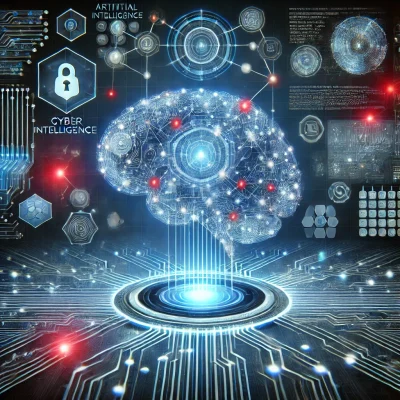
In today’s digital age, cybersecurity is a critical concern for businesses, governments, and individuals alike. With cyber threats becoming increasingly sophisticated and frequent, traditional methods of defense are often insufficient to keep up with the evolving landscape. This is where Artificial Intelligence (AI) steps in, revolutionizing the way we approach threat detection and prevention. By leveraging machine learning, automation, and advanced algorithms, AI is transforming cybersecurity, making it more proactive, efficient, and responsive.
The Rising Importance of AI in Cybersecurity
As organizations become more digitized, the amount of data they handle grows exponentially. With this growth comes an increased risk of cyberattacks, including data breaches, malware, ransomware, and phishing. Traditional cybersecurity systems rely heavily on human intervention, rule-based models, and known threat signatures, which can leave them vulnerable to new and unknown attacks.
Find out how businesses are adopting AI solutions to improve their threat management.
AI addresses these challenges by providing automated, intelligent systems that can analyze vast amounts of data in real time. It enables cybersecurity systems to learn from past data, recognize patterns, and detect anomalies. This allows for faster response times and more accurate threat identification, even for previously unknown or evolving threats.
How AI Enhances Threat Detection
One of the most significant advantages of AI in cybersecurity is its ability to detect threats more effectively than traditional systems. Here’s how AI enhances threat detection:
- Behavioral Analysis: AI systems can analyze user behavior and network traffic to identify unusual or suspicious activities. This is particularly useful in detecting insider threats, where the attacker already has access to the system.
- Anomaly Detection: AI-powered systems can identify deviations from the norm, even if the exact nature of the attack is unknown. Machine learning algorithms can analyze historical data to create a baseline of what “normal” activity looks like and flag any irregularities.
- Advanced Malware Detection: Traditional antivirus programs rely on known malware signatures to identify threats. AI, on the other hand, can detect previously unseen malware by analyzing its behavior rather than relying on a pre-existing signature.
Image alt text: Example of AI detecting malware in cybersecurity systems.
- Real-Time Monitoring: AI allows for continuous monitoring of systems and networks, offering real-time insights into potential threats. This proactive approach ensures that potential breaches are detected early, allowing security teams to respond swiftly.
AI in Cybersecurity Prevention
While detection is crucial, preventing attacks before they occur is the ultimate goal of any cybersecurity strategy. AI plays a key role in prevention through several mechanisms:
- Predictive Analysis: By analyzing vast amounts of data from past cyberattacks, AI can predict potential future threats. This enables organizations to strengthen their defenses before an attack even happens.For more insights, see how predictive analytics are being used in cybersecurity.
- Automated Patch Management: One of the most common ways hackers exploit systems is by targeting known vulnerabilities that haven’t been patched. AI can automate the process of identifying vulnerabilities and applying patches, reducing the window of opportunity for attackers.
- Improved Incident Response: AI can assist in automating responses to low-level threats, such as quarantining infected files or blocking suspicious IP addresses. This frees up human security teams to focus on more complex threats.
- User Authentication: AI can enhance user authentication by incorporating biometrics and behavioral data. For example, AI can analyze how a user types or moves their mouse to ensure it matches their normal behavior, reducing the risk of unauthorized access.
Challenges and Considerations
Despite its many benefits, AI in cybersecurity is not without its challenges. One of the primary concerns is the risk of false positives, where legitimate activities are flagged as threats. This can overwhelm security teams and lead to unnecessary downtime. However, as AI systems continue to evolve, their accuracy in distinguishing between real threats and false positives is improving.
Another concern is the use of AI by cybercriminals. Just as organizations are using AI to defend against attacks, hackers are also employing AI to develop more sophisticated attacks, such as AI-powered malware or automated phishing campaigns. This highlights the importance of staying ahead of the curve by continuously improving AI-powered defenses.
The Future of AI in Cybersecurity
As cyber threats continue to evolve, the role of AI in cybersecurity will only become more prominent. The ability of AI to learn, adapt, and respond to new threats makes it an invaluable tool in the fight against cybercrime. In the future, we can expect AI to play an even larger role in areas such as automated threat hunting, threat intelligence sharing, and integrating with Internet of Things (IoT) security.
Furthermore, the combination of AI with other emerging technologies like blockchain and quantum computing will further enhance the capabilities of cybersecurity systems, offering more robust protection against cyberattacks.
Conclusion
AI is transforming cybersecurity by offering more efficient and effective ways to detect and prevent cyber threats. Its ability to analyze vast amounts of data, detect anomalies, and automate responses makes it an essential tool for modern cybersecurity strategies. While challenges remain, the potential for AI to revolutionize cybersecurity is immense, and its continued development will be key to keeping organizations safe in an increasingly digital world.
By staying informed and investing in AI-driven cybersecurity solutions, businesses and individuals alike can ensure they are better prepared to face the ever-evolving cyber threat landscape.
#AIInCybersecurity #ThreatDetection #CyberSecuritySolutions #AIDrivenSecurity #ArtificialIntelligence #CybersecurityInnovation #SoasTech #TechInnovation #ThreatPrevention #MachineLearning #DataSecurity #CybersecurityTrends #AIDevelopment #FutureOfSecurity #DigitalTransformation
